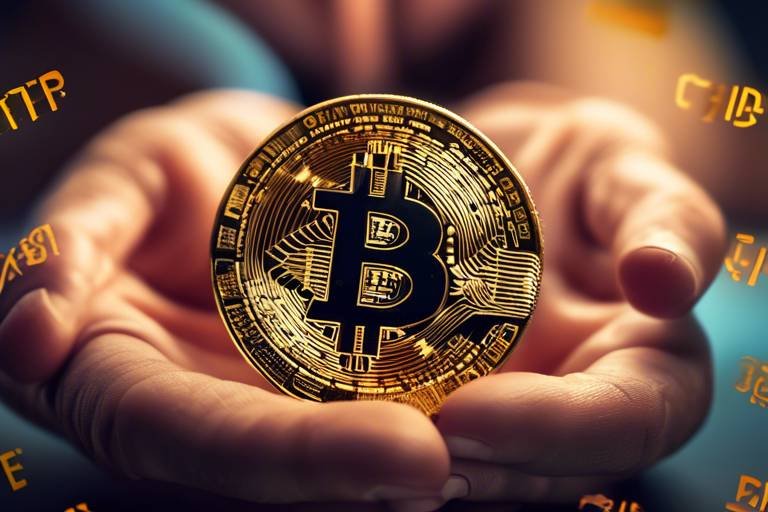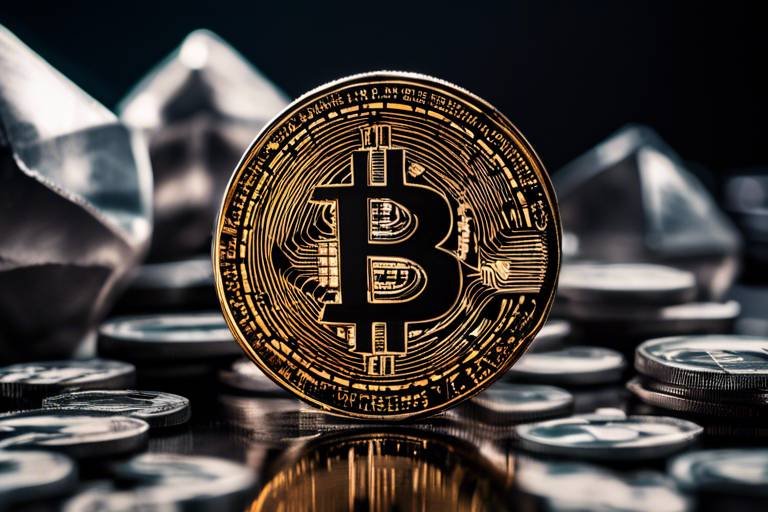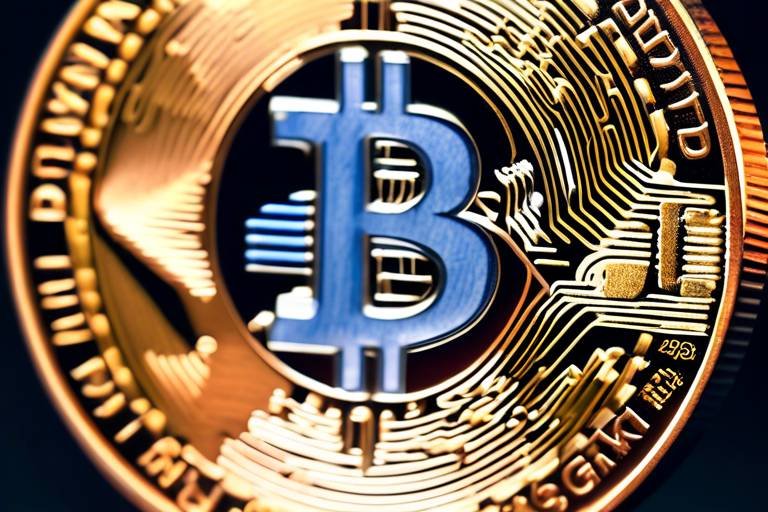Understanding the Relationship Between Crypto and Inflation Rates
In today’s rapidly evolving financial landscape, the intersection of cryptocurrency and inflation rates has become a hot topic among investors and economists alike. As inflation continues to fluctuate, many are left wondering how these economic shifts impact digital assets like Bitcoin, Ethereum, and others. The relationship between inflation and cryptocurrency is not just a passing trend; it’s a crucial factor that can shape investment strategies and market behavior. So, what’s the deal? Let’s dive into the nitty-gritty of how inflation rates influence the crypto market and why this matters to you.
Inflation is essentially the rate at which the general level of prices for goods and services rises, leading to a decrease in the purchasing power of money. Think of it as your dollar losing its muscle over time. When inflation rises, each dollar you own buys fewer goods and services. This phenomenon can be caused by a variety of factors, including increased demand for products, higher production costs, or even government policies. Understanding these causes and effects is crucial for grasping the relationship between inflation and cryptocurrencies.
Many investors are turning to cryptocurrencies as a potential hedge against inflation. Why? Well, one of the key characteristics of cryptocurrencies is their limited supply. For instance, Bitcoin has a cap of 21 million coins, which means it can’t be printed or inflated like traditional currencies. When inflation rises, the value of fiat currencies tends to decline, but cryptocurrencies can potentially preserve their value. This makes them an attractive option for those looking to safeguard their investments. But is it enough? Let’s explore further.
Looking back at historical inflation rates and their impact on cryptocurrency prices reveals some intriguing patterns. For example, during periods of high inflation, such as in the 1970s or the more recent pandemic-induced economic turmoil, we can observe how Bitcoin and other cryptocurrencies reacted. Investors who understood these trends were often better positioned to navigate the choppy waters of the crypto market. By analyzing past data, we can gain valuable insights into current investment strategies and expectations in the face of rising inflation.
Let’s take a closer look at Bitcoin’s performance during specific periods of high inflation. The 1970s were marked by soaring inflation rates, and surprisingly, Bitcoin wasn’t around then. However, during the pandemic, we saw inflation rates spike, and Bitcoin experienced a significant surge in value. This has led many to consider Bitcoin as a safe haven asset during turbulent economic times. By examining these case studies, we can gain a clearer understanding of Bitcoin’s role in an inflationary environment.
When comparing cryptocurrencies to traditional assets like gold and stocks during inflationary periods, it’s essential to highlight their relative strengths and weaknesses. For instance, gold has long been viewed as a reliable hedge against inflation, but cryptocurrencies are now emerging as a formidable contender. Here’s a quick comparison:
| Asset Type | Performance During Inflation | Liquidity | Volatility |
|---|---|---|---|
| Gold | Generally stable | High | Low |
| Stocks | Varied | Very High | High |
| Cryptocurrencies | Potentially high | Very High | Very High |
This table illustrates how different asset types respond to inflation, helping investors make informed decisions.
Market sentiment plays a pivotal role in cryptocurrency pricing. When inflation news hits the headlines, it can trigger a flurry of activity among investors. Understanding how this sentiment affects behavior is key to predicting price movements in the crypto market. For instance, if inflation rates are expected to rise, investors might flock to cryptocurrencies, driving prices up. Conversely, negative news can lead to panic selling. It’s a rollercoaster ride, and being aware of these dynamics can help you navigate the market more effectively.
Central banks have a significant influence on inflation through their monetary policies. Their decisions regarding interest rates and money supply can directly impact both fiat currencies and cryptocurrencies. For instance, when central banks lower interest rates, it can lead to increased borrowing and spending, which may drive inflation higher. This can, in turn, affect investor expectations and market dynamics in the crypto space.
Interest rates set by central banks can have a profound impact on the attractiveness of cryptocurrencies as an investment. When interest rates are low, the opportunity cost of holding cash is reduced, making cryptocurrencies more appealing. Conversely, rising interest rates can lead to a decrease in crypto investments as traditional savings become more attractive. Understanding this relationship is crucial for anyone looking to invest in digital assets.
Looking ahead, we can anticipate several potential trends for cryptocurrencies in an inflationary environment. Factors such as regulatory changes, technological advancements, and evolving market dynamics will play a significant role in shaping the future of digital assets. As investors, staying informed about these trends will be vital for making sound investment decisions.
- Can cryptocurrencies really protect against inflation? Yes, many investors view cryptocurrencies like Bitcoin as a hedge against inflation due to their limited supply.
- How does inflation affect Bitcoin? Historically, Bitcoin has shown resilience during inflationary periods, often leading to price increases.
- What role do central banks play in the crypto market? Central banks influence inflation and interest rates, which can directly impact the attractiveness of cryptocurrencies.

The Basics of Inflation
Inflation is a term that gets thrown around a lot, but what does it really mean? In simple terms, inflation is the rate at which the general level of prices for goods and services rises, leading to a decrease in the purchasing power of money. Imagine going to your favorite store and noticing that the price of a loaf of bread has gone up. That’s inflation at work! It’s like a sneaky thief that gradually steals your ability to buy the same amount of stuff with the same amount of cash.
Understanding inflation is crucial for anyone interested in finance, especially when it comes to investing in cryptocurrencies. So, what causes inflation? There are a few key factors:
- Demand-Pull Inflation: This occurs when demand for goods and services exceeds their supply. Think of it as a concert where everyone wants a ticket, but there are only a few available. Prices go up!
- Cost-Push Inflation: This happens when the costs of production increase, causing businesses to raise prices to maintain their profit margins. Imagine if the price of oil skyrockets; everything that relies on oil, from transportation to manufacturing, will likely see a price hike.
- Built-In Inflation: This is related to the wage-price spiral. As prices rise, workers demand higher wages to keep up, which can lead to further price increases.
Inflation isn’t inherently bad; it can be a sign of a growing economy. However, when it spirals out of control, it can lead to economic instability. For instance, hyperinflation can make everyday essentials unaffordable, leading to unrest and a loss of confidence in the currency. This is where cryptocurrencies come into play.
One of the most fascinating aspects of inflation is how it affects different asset classes. While traditional currencies may lose their value over time due to inflation, many investors are turning to cryptocurrencies as a potential safeguard. Why? Because many cryptocurrencies, like Bitcoin, have a capped supply, meaning there will only ever be a finite number of them available. This limited supply can create a sense of scarcity, which is attractive to investors looking to preserve their wealth in an inflationary environment.
In the next sections, we will delve deeper into how cryptocurrencies function as a hedge against inflation, providing historical context and case studies that illustrate their performance during inflationary periods. So, buckle up as we explore this intriguing relationship between inflation and digital assets!

How Crypto Functions as a Hedge Against Inflation
In an age where inflation seems to be a constant companion, many investors are turning their eyes towards cryptocurrencies as a potential hedge against rising prices. But what does this really mean? To put it simply, when traditional currencies lose their purchasing power due to inflation, digital assets like Bitcoin and Ethereum may offer a more stable alternative. This is primarily because most cryptocurrencies have a limited supply, which means they can't be inflated in the same way that fiat currencies can be printed at will by central banks.
Imagine you have a limited edition collectible item; as the number of items decreases, their value often increases due to scarcity. Similarly, cryptocurrencies like Bitcoin are capped at 21 million coins. This built-in scarcity can potentially preserve value in times of economic turmoil. When people fear that their money will lose value, they often seek out assets that can hold or even increase their worth. This is where crypto shines, as it provides an alternative store of value.
Furthermore, the underlying technology of cryptocurrencies, blockchain, offers transparency and security that traditional banking systems often lack. In times of economic uncertainty, trust in these institutions can wane, leading investors to seek refuge in decentralized assets. The allure of crypto as a hedge is not just theoretical; historical data shows that during high inflation periods, cryptocurrencies have often experienced price surges. For example, during the recent pandemic, many investors flocked to Bitcoin, pushing its price to new heights as traditional markets faltered.
However, it’s important to note that while cryptocurrencies can act as a hedge, they are not without their risks. The crypto market is notoriously volatile, and prices can swing dramatically in short periods. Thus, while they may offer protection against inflation, they also come with the potential for significant losses. The key for investors is to balance their portfolios, combining traditional assets with cryptocurrencies to mitigate risks.
To illustrate the relationship between inflation and cryptocurrency performance, consider the following table that outlines key inflationary periods and the corresponding price movements of Bitcoin:
| Year | Inflation Rate (%) | Bitcoin Price (USD) |
|---|---|---|
| 1970s | 7.5 - 13.5 | N/A |
| 2020 | 1.2 | $7,200 |
| 2021 | 5.4 | $41,000 |
| 2022 | 8.0 | $19,000 |
This table highlights how Bitcoin has responded during different inflationary periods. While the data from the 1970s is not applicable since Bitcoin did not exist then, the more recent years show a clear trend: as inflation rises, so too can the price of Bitcoin, albeit with volatility. This dynamic has led many to conclude that cryptocurrencies can serve as a protective barrier against inflation, even if the path is not always smooth.
In conclusion, while cryptocurrencies are not a foolproof solution to inflation, they offer a unique alternative that traditional assets may not provide. As the economic landscape continues to evolve, understanding how to leverage these digital assets effectively will be crucial for investors looking to safeguard their wealth against the ravages of inflation.
- Can cryptocurrencies completely protect against inflation? While they can provide a hedge, they are not immune to volatility.
- What is the best cryptocurrency to invest in for inflation protection? Bitcoin is often seen as the gold standard, but other cryptocurrencies may also offer potential.
- How can I start investing in cryptocurrencies? You can start by researching exchanges, creating an account, and purchasing your desired cryptocurrency.

Historical Context of Crypto and Inflation
To truly grasp the relationship between cryptocurrencies and inflation, it’s essential to take a step back and look at the historical context. The world has witnessed numerous inflationary periods, each with its own unique characteristics and implications for various asset classes. When we analyze these times, especially the notorious inflation spikes of the 1970s and the more recent economic disruptions caused by the COVID-19 pandemic, we start to see patterns emerge that are critical for investors.
During the 1970s, a combination of oil crises and expansive monetary policy led to soaring inflation rates in many countries. As the purchasing power of traditional currencies dwindled, investors began seeking alternative assets to preserve their wealth. This was a pivotal moment that set the stage for the later emergence of cryptocurrencies. Fast forward to the present, and we find ourselves in a similar situation where rising inflation rates have renewed interest in digital assets, particularly Bitcoin.
Bitcoin, launched in 2009, was designed with a limited supply of 21 million coins, making it inherently deflationary. This characteristic is what draws many investors to view it as a hedge against inflation. When inflation rises, the fear of losing purchasing power pushes investors to look for assets that can potentially hold or even increase their value. Historical data shows that, during inflationary periods, Bitcoin has often experienced significant price surges, indicating its appeal as a safe haven asset.
To illustrate this point further, let’s consider a comparison of inflation rates and Bitcoin prices over the years:
| Year | Inflation Rate (%) | Bitcoin Price (USD) |
|---|---|---|
| 2010 | 1.64 | 0.06 |
| 2011 | 3.16 | 0.30 |
| 2013 | 1.50 | 120.00 |
| 2020 | 1.23 | 29,000.00 |
| 2021 | 7.00 | 64,000.00 |
This table highlights the correlation between rising inflation rates and increasing Bitcoin prices. As inflation rates began to climb, particularly in 2021, Bitcoin's value surged to unprecedented heights, reinforcing the notion that investors are turning to cryptocurrencies as a hedge against inflation.
Moreover, it’s important to note that other cryptocurrencies also began to emerge during these inflationary periods, each with unique characteristics that appealed to different investor sentiments. For instance, Ethereum, with its smart contract capabilities, gained traction as a versatile asset beyond just a store of value.
In summary, the historical context of inflation and its impact on cryptocurrencies reveals a complex yet fascinating relationship. As inflationary pressures mount, the allure of digital assets continues to grow, presenting both opportunities and challenges for investors navigating this volatile landscape. Understanding these historical patterns is crucial for anyone looking to invest in cryptocurrencies today, as it can help inform strategies and expectations in the face of rising economic uncertainty.
- What is the relationship between inflation and cryptocurrency? Inflation often leads investors to seek alternative assets like cryptocurrencies, which can potentially preserve value when traditional currencies are losing purchasing power.
- Can cryptocurrencies act as a hedge against inflation? Yes, many investors view cryptocurrencies, particularly Bitcoin, as a hedge against inflation due to their limited supply and deflationary nature.
- How have historical inflation rates influenced cryptocurrency prices? Historical data indicates a correlation where rising inflation rates often coincide with increases in cryptocurrency prices, particularly Bitcoin.

Case Studies: Bitcoin During Inflationary Periods
When we delve into the historical performance of Bitcoin during inflationary periods, we uncover some fascinating insights that can help investors navigate the often-turbulent waters of economic uncertainty. One of the most notable instances is the inflation surge of the 1970s, a decade marked by soaring prices and economic stagnation. During this time, traditional assets like stocks struggled, while Bitcoin, which was still in its infancy, began to gain traction as a potential hedge against inflation. Although Bitcoin wasn’t widely recognized back then, the principles that underpin its value—limited supply and decentralized nature—began to resonate with a growing number of investors seeking alternatives to traditional fiat currencies.
Fast forward to the COVID-19 pandemic, and we see another compelling case study. In 2020, governments around the world implemented unprecedented monetary policies, flooding the economy with stimulus checks and lowering interest rates to near-zero. As inflation fears began to creep into the collective consciousness, Bitcoin experienced a meteoric rise. From around $7,000 in March 2020, it surged past $60,000 by April 2021. This impressive rally was fueled by the perception of Bitcoin as a "digital gold," a store of value that could withstand the erosion of purchasing power caused by rampant money printing.
To better illustrate these historical contexts, let’s take a look at a comparative table showcasing Bitcoin’s price movements alongside inflation rates during significant periods:
| Year | Inflation Rate (%) | Bitcoin Price (USD) |
|---|---|---|
| 1975 | 9.14 | N/A (Bitcoin launched in 2009) |
| 2020 | 1.25 | $7,000 |
| 2021 | 5.39 (projected) | $60,000+ |
As we analyze these trends, it becomes clear that Bitcoin's performance during inflationary periods can be quite telling. Investors often flock to Bitcoin in search of a safe haven, which can lead to increased demand and, consequently, higher prices. This phenomenon is not merely anecdotal; it reflects a broader shift in investor sentiment towards recognizing Bitcoin as a viable asset class that can potentially outperform traditional investments during economic downturns.
Moreover, the correlation between Bitcoin's price and inflation rates suggests that as inflation rises, so does interest in Bitcoin as an inflation hedge. This dynamic creates a compelling narrative for investors to consider Bitcoin not just as a speculative asset but as a strategic component of their portfolios, especially in times of economic uncertainty.
In conclusion, the case studies of Bitcoin during inflationary periods highlight its potential as a protective asset. By understanding these historical contexts, investors can make more informed decisions about their cryptocurrency investments, particularly when faced with rising inflation and volatile economic conditions.

Comparative Analysis with Traditional Assets
When diving into the world of investments, it's essential to understand how cryptocurrencies stack up against traditional assets like stocks and gold, especially during inflationary periods. Both asset classes have their unique characteristics and can react differently to economic pressures. For instance, while traditional assets often provide a sense of stability, cryptocurrencies are known for their volatility and potential for high returns. But how do these two worlds collide when inflation starts to rear its ugly head?
Historically, gold has been viewed as a safe haven during inflationary times. Investors flock to it as a tangible asset that typically retains its value, even when fiat currencies are losing purchasing power. In contrast, cryptocurrencies, particularly Bitcoin, have emerged as a modern alternative to gold. With a capped supply of 21 million coins, Bitcoin is often touted as "digital gold," providing a hedge against inflation much like its metallic counterpart.
To illustrate the comparative performance of these assets during inflationary periods, let’s take a look at some key metrics:
| Asset Class | Average Annual Return (Inflationary Periods) | Volatility Index | Liquidity |
|---|---|---|---|
| Gold | 5-7% | Low | High |
| Stocks | 7-10% | Medium | Very High |
| Bitcoin | 200-300% | High | High |
As shown in the table, Bitcoin's average annual return during inflationary periods is significantly higher than that of gold and stocks. However, this comes with a caveat: its volatility index is much higher, which means while the potential for greater returns exists, so does the risk of substantial losses. In contrast, gold offers a more stable investment, albeit with lower returns.
Another key factor to consider is liquidity. Cryptocurrencies are traded 24/7, providing investors with the flexibility to buy and sell at any time. Traditional assets like gold and stocks, while also liquid, may not offer the same level of accessibility, especially during market downturns. This liquidity can be a double-edged sword; while it allows for quick transactions, it can also lead to rapid price fluctuations, driven by market sentiment and news.
In summary, while cryptocurrencies like Bitcoin offer the allure of high returns and liquidity, traditional assets such as gold and stocks provide stability and lower volatility. The choice between these asset classes ultimately depends on an investor's risk tolerance, investment horizon, and market outlook. As inflation continues to challenge economic stability, understanding these dynamics will be crucial for making informed investment decisions.
- What is the best asset to invest in during inflation? It largely depends on your risk tolerance. Gold is traditionally seen as a safe haven, while cryptocurrencies like Bitcoin can offer higher returns but come with higher volatility.
- How does inflation affect cryptocurrency prices? Inflation can lead to increased interest in cryptocurrencies as a hedge, potentially driving prices up. However, market sentiment plays a significant role, so it's not a guaranteed outcome.
- Are cryptocurrencies a safe investment? Cryptocurrencies are known for their volatility, making them a riskier investment compared to traditional assets. It's essential to do thorough research and consider your financial goals before investing.

Market Sentiment and Crypto Prices
Market sentiment is like the weather in the world of cryptocurrencies—unpredictable, yet profoundly impactful. Just as a sunny day can lift spirits and encourage outdoor activities, positive sentiment can drive crypto prices to new heights. Conversely, a stormy forecast can send investors scrambling for cover, leading to price drops. In the crypto realm, sentiment is shaped by various factors, including news, social media trends, and global economic events. Understanding this sentiment is essential for anyone looking to navigate the volatile waters of cryptocurrency investments.
One of the most fascinating aspects of market sentiment is its ability to create self-fulfilling prophecies. When investors are optimistic about a particular cryptocurrency, they tend to buy more, driving the price up. This price increase can then attract more investors, creating a cycle of positivity. On the flip side, negative sentiment can trigger a mass sell-off, leading to significant price declines. It’s a classic case of herd behavior—when people see others making decisions, they often follow suit, regardless of their own analysis.
To illustrate this point, let’s take a closer look at how inflation news can influence market sentiment. When inflation rates rise, investors often seek assets that can retain their value. This is where cryptocurrencies come into play. If news outlets report on rising inflation, it can lead to a surge in interest for digital assets. Investors may perceive cryptocurrencies as a hedge against inflation, driving demand and consequently, prices up. On the other hand, if inflation is perceived as being under control, the urgency to invest in cryptocurrencies may diminish, leading to a drop in prices.
Additionally, social media platforms have become a hotbed for sentiment analysis. Tweets, posts, and discussions can rapidly sway public opinion and, by extension, market prices. For instance, when influential figures in the crypto space share bullish sentiments about a particular coin, it can spark a buying frenzy. Conversely, negative remarks can lead to panic selling. Investors should be aware of this dynamic, as it can lead to significant price fluctuations in a very short time.
To further understand the relationship between market sentiment and crypto prices, let's take a look at a simplified table that outlines how various sentiment indicators can affect price movements:
| Sentiment Indicator | Effect on Prices |
|---|---|
| Positive News (e.g., adoption by major companies) | Price Increase |
| Negative News (e.g., regulatory crackdowns) | Price Decrease |
| Social Media Buzz (e.g., trending hashtags) | Price Volatility |
| Market Trends (e.g., rising inflation rates) | Potential Price Surge |
In summary, market sentiment plays a crucial role in determining cryptocurrency prices. It’s a complex interplay of emotions, news, and social dynamics that investors must navigate. By staying informed and understanding how sentiment shifts can impact market trends, investors can make more strategic decisions. Remember, in the world of crypto, your intuition and awareness of the market's pulse can be just as valuable as your analytical skills.
- What is market sentiment? Market sentiment refers to the overall attitude of investors toward a particular market or asset, influenced by news, social media, and economic conditions.
- How does inflation affect cryptocurrency prices? Rising inflation can lead investors to seek alternatives like cryptocurrencies, potentially driving prices up as demand increases.
- Can social media impact crypto prices? Absolutely! Social media trends and influential figures can significantly sway public opinion and investor behavior, affecting prices.
- What strategies can I use to gauge market sentiment? Monitoring news, social media discussions, and market trends can help you get a sense of the prevailing sentiment in the crypto market.

The Role of Central Banks
Central banks are pivotal players in the economic landscape, wielding significant power over inflation through their monetary policies. These institutions, such as the Federal Reserve in the United States and the European Central Bank in Europe, are responsible for managing a nation’s currency, money supply, and interest rates. Their decisions can have far-reaching implications not only for traditional fiat currencies but also for the burgeoning cryptocurrency market. As they adjust interest rates and implement quantitative easing or tightening, they effectively shape the economic environment in which both traditional and digital assets operate.
One of the primary tools central banks use to influence inflation is the adjustment of interest rates. When central banks lower interest rates, borrowing becomes cheaper, which can stimulate economic growth. However, this can also lead to higher inflation as more money circulates in the economy. Conversely, raising interest rates can help curb inflation but may also slow down economic growth. This delicate balance is crucial for investors to understand, especially those looking at cryptocurrencies as a potential hedge against inflation.
Moreover, central banks have begun to take notice of cryptocurrencies and their growing influence. The rise of digital currencies has prompted discussions about regulation and the potential for central bank digital currencies (CBDCs). These CBDCs could offer a government-backed alternative to cryptocurrencies, fundamentally altering the landscape of digital assets. As central banks explore the implementation of their own digital currencies, the dynamics between traditional fiat currencies and cryptocurrencies will likely evolve, impacting investor sentiment and market trends.
It's important to note that the relationship between central banks and cryptocurrencies is not merely one-sided. While central banks can influence the market through their policies, the rise of cryptocurrencies also poses challenges for these institutions. For instance, if cryptocurrencies continue to gain traction as a means of exchange and store of value, central banks may find it increasingly difficult to control monetary policy effectively. This tug-of-war creates an interesting dynamic that investors need to watch closely.
To summarize, the role of central banks in the context of inflation and cryptocurrencies is complex and multifaceted. Their actions can create ripple effects across the entire financial ecosystem, influencing everything from consumer spending to investment strategies in the crypto market. Understanding this relationship is vital for investors looking to navigate the increasingly intertwined worlds of traditional finance and digital assets.
As we move forward, it’s essential for investors to stay informed about central bank policies and their potential impact on both inflation and the cryptocurrency market. The interplay between these entities will undoubtedly shape the future of finance and investment strategies in the years to come.
- How do central banks control inflation? Central banks control inflation primarily through interest rate adjustments and monetary policy tools, which influence the money supply in the economy.
- What is the impact of low interest rates on cryptocurrencies? Low interest rates can increase the attractiveness of cryptocurrencies as an investment, as they may offer higher returns compared to traditional savings accounts or bonds.
- Are central banks considering cryptocurrencies? Yes, many central banks are exploring the possibility of issuing their own digital currencies (CBDCs) and are closely monitoring the cryptocurrency market.
- How does inflation affect cryptocurrency prices? Generally, high inflation can lead to increased interest in cryptocurrencies as a hedge against the declining purchasing power of fiat currencies.

Interest Rates and Their Impact on Crypto
Interest rates are a crucial component of the economic landscape, influencing everything from consumer spending to investment strategies. When central banks adjust interest rates, they send ripples through the financial markets, including the burgeoning world of cryptocurrencies. But how exactly do these rates affect crypto? Let’s break it down.
First off, let's consider the basic premise: when interest rates rise, borrowing costs increase. This means that consumers and businesses are less likely to take out loans for spending or investment. In a high-interest environment, traditional investments like bonds and savings accounts become more attractive due to their relatively stable returns. As a result, the demand for riskier assets, including cryptocurrencies, may decrease. Investors often pull back from the volatile crypto market in favor of the security offered by higher interest rates in traditional finance.
On the flip side, when interest rates are low, borrowing becomes cheaper, and investors are often more willing to take risks. This can lead to increased investment in cryptocurrencies as people look for higher returns than what traditional savings accounts or bonds can offer. The low-interest climate of recent years has contributed to the explosive growth of the crypto market, as many investors sought alternatives to traditional assets.
To illustrate this relationship, consider the following table that summarizes the impact of interest rate changes on cryptocurrency investment:
| Interest Rate Environment | Investor Behavior | Impact on Crypto |
|---|---|---|
| High Interest Rates | Decreased borrowing and spending | Lower demand for crypto, potential price decline |
| Low Interest Rates | Increased borrowing and spending | Higher demand for crypto, potential price increase |
Moreover, the relationship between interest rates and cryptocurrency is also influenced by market sentiment. For instance, if investors anticipate that interest rates will rise, they might preemptively sell off their crypto holdings to avoid potential losses. This preemptive selling can lead to short-term volatility and price dips in the crypto market, regardless of the underlying fundamentals of the digital assets themselves.
Additionally, the correlation between interest rates and cryptocurrency is not uniform across all digital assets. For example, Bitcoin, often seen as a store of value akin to gold, may react differently compared to altcoins that are more speculative in nature. Understanding these nuances is essential for investors who want to navigate the complexities of the crypto market effectively.
In conclusion, interest rates play a significant role in shaping the cryptocurrency landscape. As central banks adjust their monetary policies, investors must stay vigilant and adapt their strategies accordingly. The interplay between interest rates and crypto is a dance of risk and reward, where understanding the rhythm can lead to more informed investment decisions.
- How do rising interest rates affect cryptocurrency prices? Rising interest rates generally lead to lower demand for cryptocurrencies as investors gravitate towards safer, interest-bearing assets.
- Can low interest rates boost cryptocurrency investment? Yes, low interest rates make borrowing cheaper, encouraging investors to seek higher returns in riskier assets like cryptocurrencies.
- Is Bitcoin affected by interest rates? Yes, Bitcoin's price can be influenced by changes in interest rates, as they impact investor sentiment and market dynamics.

Future Trends: Crypto in an Inflationary World
The landscape of cryptocurrency is constantly evolving, especially in the context of inflationary pressures. As we look to the future, several trends are emerging that could reshape how cryptocurrencies are perceived and utilized. One of the most significant trends is the increasing adoption of cryptocurrencies as a viable alternative to traditional fiat currencies. With inflation rates rising globally, many people are seeking out new ways to safeguard their wealth. Cryptocurrencies, with their decentralized nature and potential for high returns, are becoming more attractive to both retail and institutional investors.
Moreover, the integration of blockchain technology into everyday financial transactions is likely to gain momentum. As people become more familiar with digital currencies and their benefits, we could see a shift towards using cryptocurrencies for everyday purchases. This shift could be further accelerated by technological advancements, such as the development of user-friendly wallets and secure payment systems that make transactions seamless and safe.
Another trend to watch is the regulatory landscape surrounding cryptocurrencies. Governments around the world are beginning to take a closer look at how to regulate digital assets, which could lead to increased legitimacy and stability in the market. While some regulations may initially seem restrictive, they could ultimately foster a more secure environment for investors. By establishing clear guidelines, regulators may help to reduce the volatility that often accompanies the crypto market, making it a more appealing option for those concerned about inflation.
In addition, the rise of decentralized finance (DeFi) is expected to continue influencing the crypto market. DeFi platforms allow users to lend, borrow, and earn interest on their crypto holdings without the need for traditional banks. This trend not only democratizes access to financial services but also provides an avenue for individuals to generate returns on their assets, potentially outpacing inflation. As more people turn to DeFi, we might witness an increase in the demand for cryptocurrencies, further driving their value.
It's also important to consider the role of stablecoins in an inflationary world. These cryptocurrencies, pegged to traditional assets like the US dollar or gold, provide a way to mitigate the volatility associated with other digital assets. As inflation erodes purchasing power, stablecoins could become a preferred choice for those looking to maintain value while still participating in the crypto market. Their appeal lies in their ability to combine the benefits of cryptocurrencies with the stability of traditional currencies.
In summary, the future of cryptocurrencies in an inflationary world looks promising. With increasing adoption, technological advancements, evolving regulations, and the rise of DeFi and stablecoins, digital assets are poised to play a significant role in reshaping the financial landscape. Investors who keep an eye on these trends may find new opportunities to navigate the complexities of inflation and protect their wealth in innovative ways.
- What is the relationship between inflation and cryptocurrency?
Inflation can erode the purchasing power of traditional currencies, leading many investors to seek alternatives like cryptocurrencies, which have a limited supply and the potential to preserve value.
- How can cryptocurrencies serve as a hedge against inflation?
Due to their finite supply and decentralized nature, cryptocurrencies can offer a means of preserving wealth when fiat currencies lose value due to inflationary pressures.
- What impact do regulations have on the crypto market?
Regulations can provide clarity and security, potentially reducing volatility and increasing investor confidence in cryptocurrencies.
- Are stablecoins a good investment during inflation?
Stablecoins can offer a safer alternative during inflationary periods, allowing investors to maintain value while still engaging with the crypto market.
Frequently Asked Questions
- What is inflation and why is it important?
Inflation refers to the rate at which the general level of prices for goods and services rises, leading to a decrease in purchasing power. It's important because it affects how much you can buy with your money and influences economic decisions, including investments in cryptocurrencies.
- How do cryptocurrencies act as a hedge against inflation?
Many investors see cryptocurrencies as a hedge against inflation due to their limited supply, especially in the case of Bitcoin. When traditional currencies lose value, digital assets may retain or even increase their value, offering a potential safe haven for investors.
- What historical events have impacted the relationship between crypto and inflation?
Historical periods of high inflation, like the 1970s or the recent pandemic, show how cryptocurrencies, particularly Bitcoin, have performed during such times. These events provide valuable insights into how crypto can act as a refuge when fiat currencies struggle.
- How do cryptocurrencies compare to traditional assets during inflation?
When comparing cryptocurrencies to traditional assets like gold and stocks, it's evident that each has its strengths and weaknesses during inflationary periods. Cryptocurrencies often show higher volatility, while gold has been a long-standing safe haven.
- What role does market sentiment play in crypto prices?
Market sentiment significantly influences cryptocurrency pricing. News about inflation can lead to panic or excitement among investors, which in turn affects price movements. Understanding this sentiment can help predict potential trends in the crypto market.
- How do central banks influence inflation and cryptocurrencies?
Central banks control monetary policy, which directly impacts inflation rates. Their actions can influence investor expectations and market dynamics, affecting both fiat currencies and cryptocurrencies. For instance, interest rate changes can make crypto investments more or less attractive.
- What is the impact of interest rates on cryptocurrency investments?
Interest rates set by central banks can affect how appealing cryptocurrencies are to investors. Lower interest rates often encourage investment in riskier assets like crypto, while higher rates might drive investors back to safer, traditional investments.
- What are the future trends for cryptocurrencies in an inflationary environment?
Looking ahead, cryptocurrencies may continue to evolve in response to inflation. Factors like regulatory changes, technological advancements, and shifting market dynamics will play crucial roles in shaping the future of digital assets in an inflationary world.



















